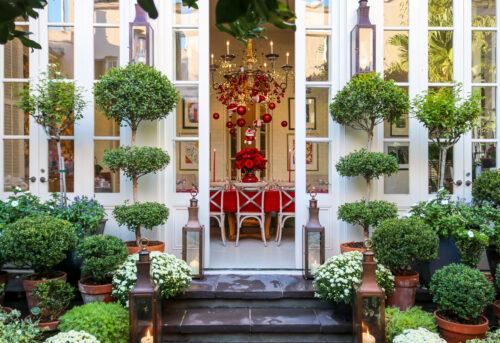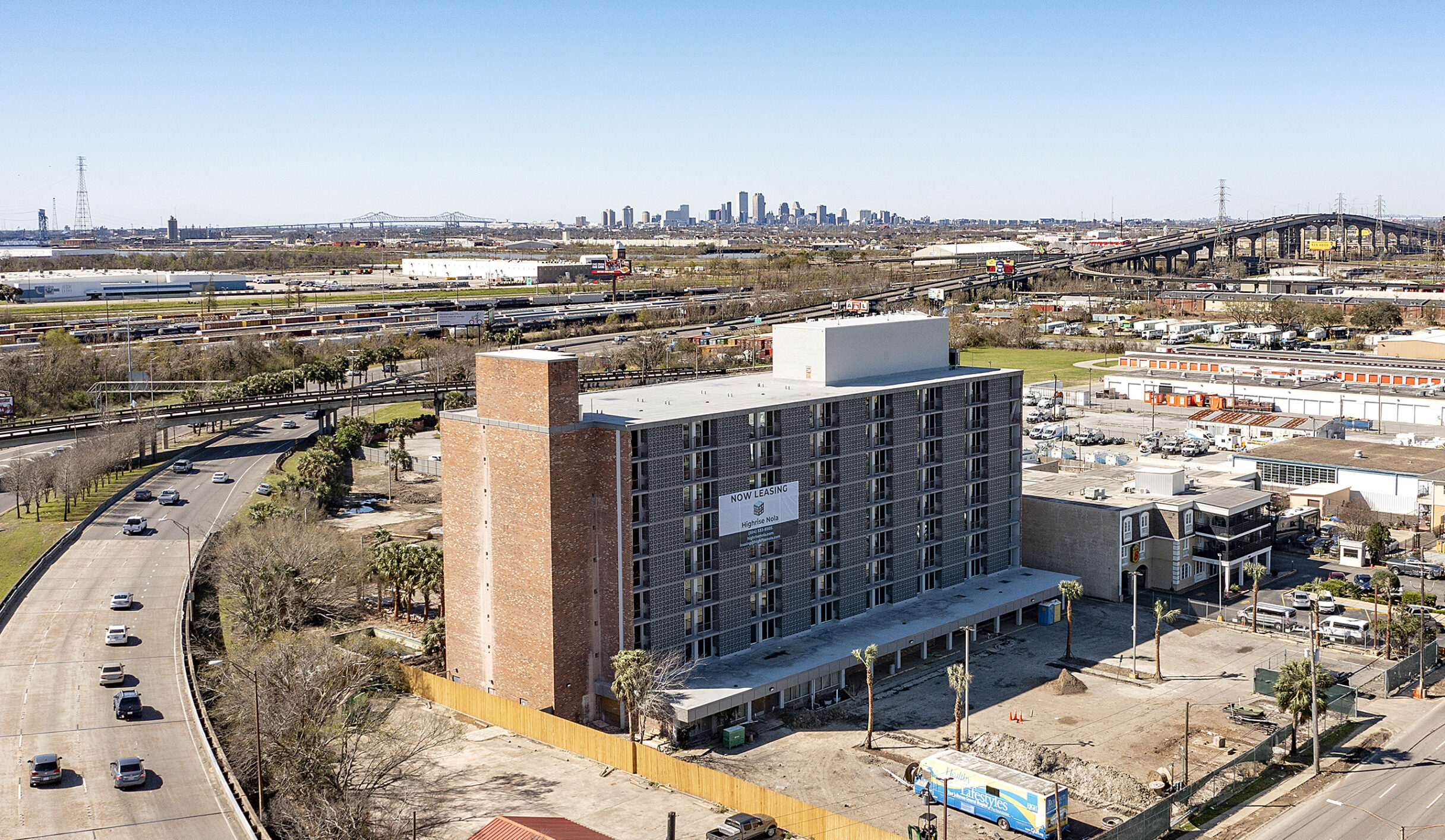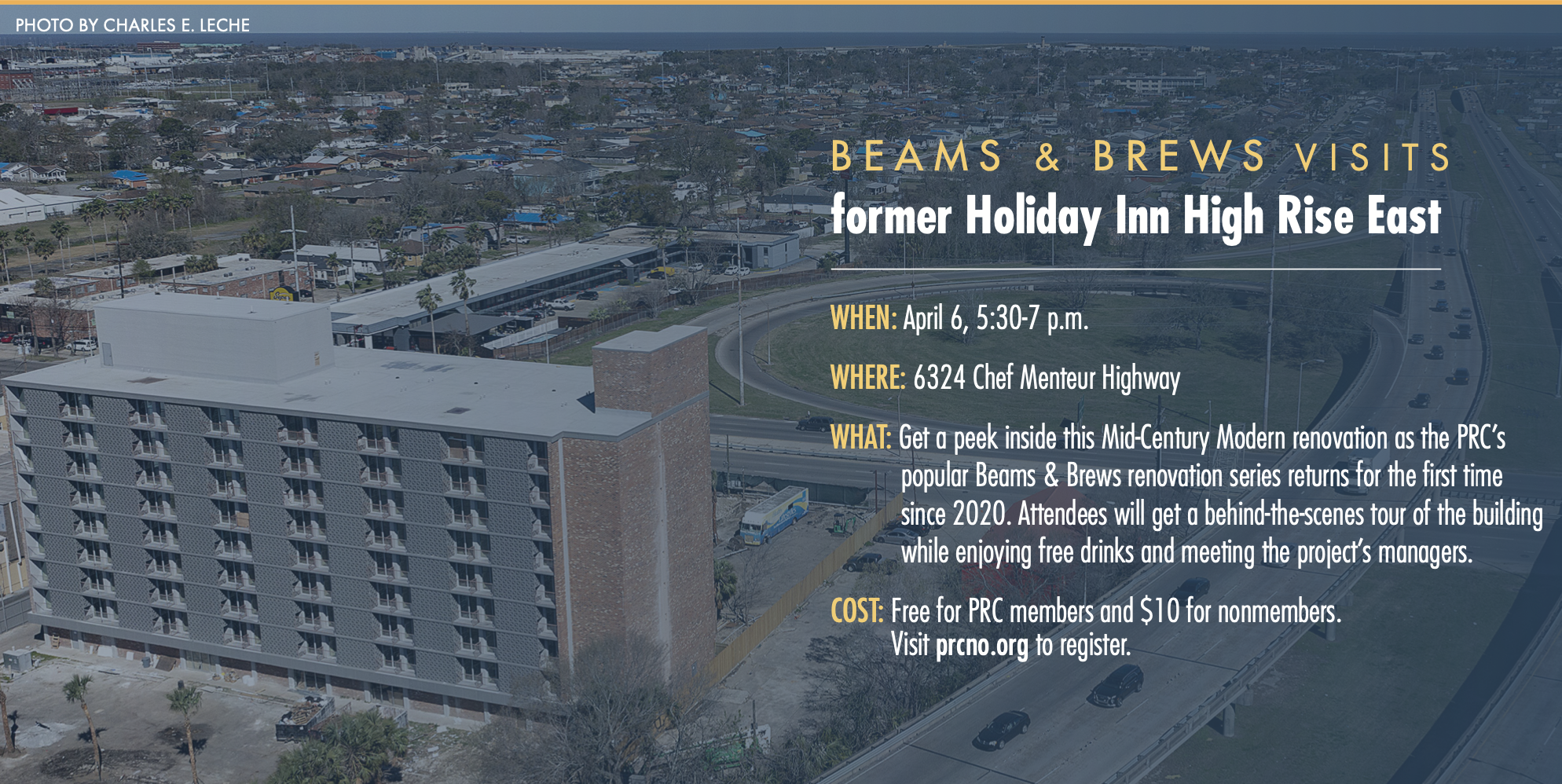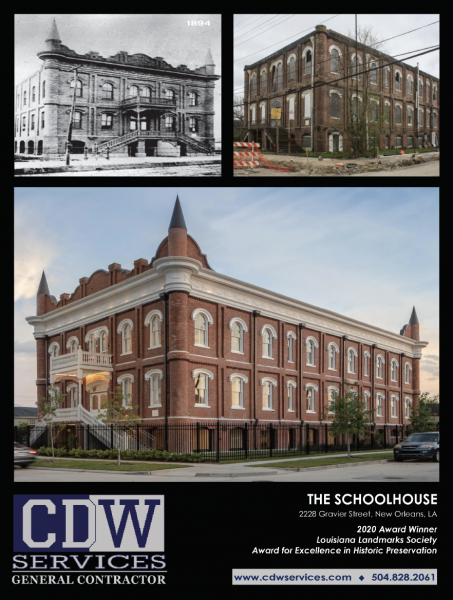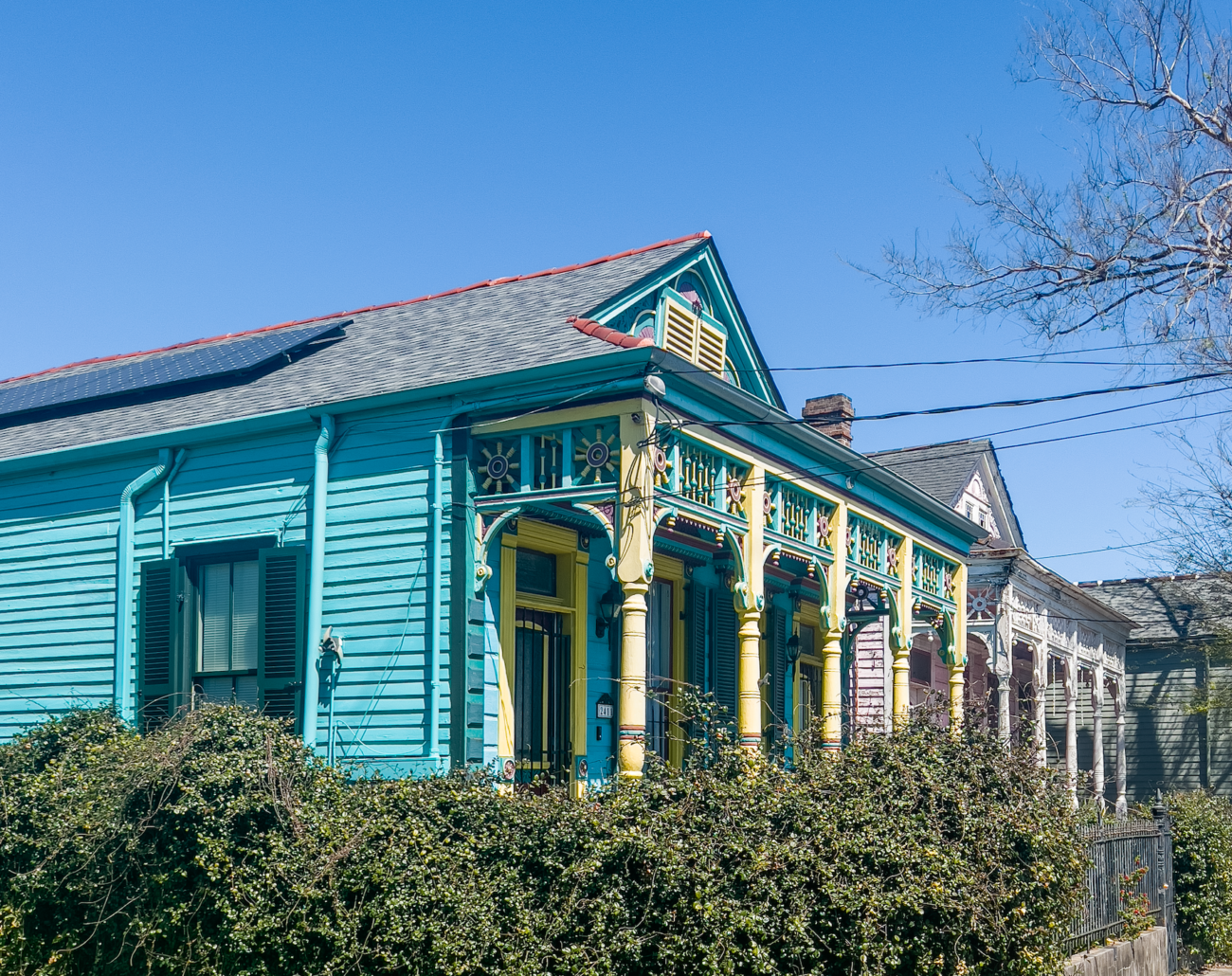Join the PRC on April 6 to get a behind-the-scenes renovation tour of this building while enjoying free drinks!
Beams & Brews visits the former Holiday Inn High Rise East
April 6, 5:30 pm • 6324 Chef Menteur Hwy • Free for members / $10 nonmembers • Learn more & RSVP
Above photo by Charles E. Leche
Since its construction in 1968, a towering Holiday Inn building has stood as a beacon to motorists traveling into the Crescent City on Interstate 10. Perched next to the I-10 High Rise Bridge, the hotel served travelers for decades, with its cast concrete breeze blocks beckoning visitors to the city. After falling into vacancy in 2005, the building became a highly visible symbol of blight, with its fading facade serving as a large-scale canvas for unwelcome graffiti.
Now, following an extensive multi-year renovation, the restored building at 6324 Chef Menteur Highway is breathing new life — and financial investment — into this corner of New Orleans East. Reborn as the “Highrise Nola” apartment building, the historic tower will soon welcome its first long-term residents later this spring.
“A building of that size with that level of blight was an eyesore for not only New Orleans East but the entire city,” said Peter Gardner, the project’s developer. “Seeing it redeveloped was really important for people, especially for people in New Orleans East, that they see positive investments being made, eliminating blight and things moving in a positive direction.”
 Historic postcard courtesy of the National Register Database, Louisiana. Images courtesy of Google Maps.
Historic postcard courtesy of the National Register Database, Louisiana. Images courtesy of Google Maps.
The project, led by Gardner and his company Gardner Development LLC, has been years in the making. Gardner has been restoring and returning once-blighted buildings to commerce over the past 20 years, but the high-rise project has been the largest of its scale during his career. He has had hands-on involvement from the project’s start to finish over the past five years, acting as the site’s owner, developer and general contractor.
In 2017, Gardner purchased the vacant structure from a colleague who had previously bought the blighted building at auction from the Orleans Parish Sheriff’s Office. “I had been growing the types of projects I did, but I really hadn’t done anything of this size and thought it could be an affordable opportunity,” Gardner said. “I went ahead and bought it on a whim and didn’t even walk the entirety of the inside of the building before I bought it.”
With the building approaching 50 years old, Gardner was hopeful to nominate the modernist high-rise to the National Register of Historic Places. After meeting with consultants who researched the building’s history and were initially doubtful that the structure would qualify, Gardner hired Tulane Master of Preservation Studies student Emily Knollenberg to explore the building’s nomination process as an internship project. Knollenberg prepared the documentation and began discussions with the State Historic Preservation office, which was concurrently working to approve a multi-property submission of other mid-century commercial buildings in New Orleans. That multi-property submission was intended to serve as a framework for future nominations of mid-century buildings, and the former Holiday Inn was a perfect candidate of the architectural type to be nominated to the register.
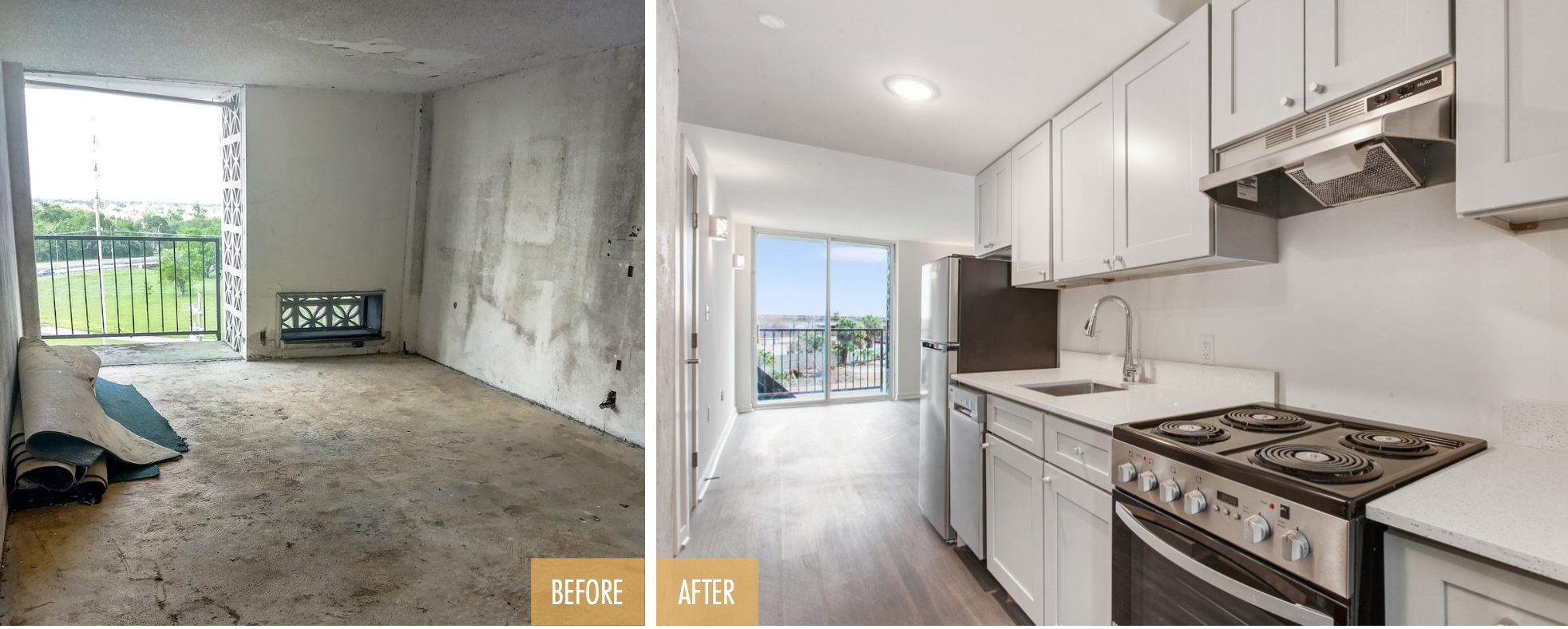 The building’s once-vacant hotel rooms have been renovated into 144 new apartment units. Before photo courtesy of the National Register Database, Louisiana; after photo courtesy of Highrise NOLA.
The building’s once-vacant hotel rooms have been renovated into 144 new apartment units. Before photo courtesy of the National Register Database, Louisiana; after photo courtesy of Highrise NOLA.
“The Non-Residential Mid-Century Modern Architecture in New Orleans multiple-property submission provides a historic context for mid-century modern architecture in New Orleans as well as registration requirements for commercial, institutional and civic buildings to be nominated,” wrote Emily Ardoin, National Register coordinator for the Louisiana Division of Historic Preservation, in Preservation In Print’s February 2020 issue. “The Holiday Inn Highrise East was the first building nominated as part of this multiple-property submission. It is…an important example of the Corporate Commercial subtype of mid-century modern commercial architecture in New Orleans.”
“When we made the presentation, there were 10 people on the panel and nine of them said yes, so we got it listed,” Gardner said.
Advertisement
According to its National Register nomination, the building was designed by the architecture firm of William Bond and constructed in 1968. The facade’s signature concrete breeze blocks were designed to be decorative and functional, hiding the HVAC units for each room. Bond designed many Holiday Inn buildings during the company’s early years, with each building intended to serve as a billboard for the hotel chain — catching motorists’ eyes as they passed by on the then-new federal interstate system — through bold neon signage and a uniform architectural design. Although the building had deteriorated during the post-Hurricane Katrina years, it still retained most of its original features.
“This was a particular Holiday Inn design that they built maybe eight to 10 times across the United States, and this is the only one still standing in its original condition,” Gardner said. “I think it’s cool that it’s now going to be around for another hundred years as it looked when it was first built.”
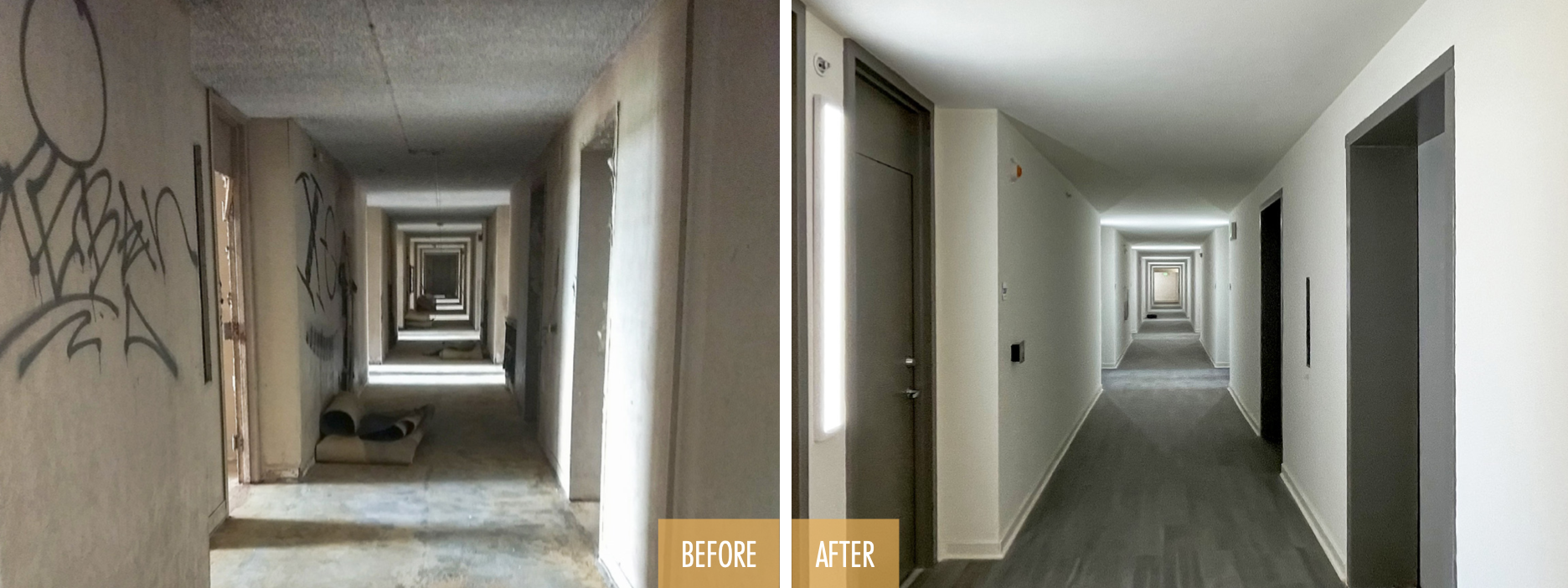 An interior hallway, before and after the building’s renovation. Before photo courtesy of the National Register Database, Louisiana; after photo by Davis Allen.
An interior hallway, before and after the building’s renovation. Before photo courtesy of the National Register Database, Louisiana; after photo by Davis Allen.
Once the building was added to the National Register, its rehabilitation became eligible for state and federal historic rehabilitation tax credits. When combined, the credits can cover up to 40 percent of qualifying rehabilitation costs on a historic building. “I don’t think the project would have been possible without it,” Gardner said.
After securing financing for the $12 million project, the building’s physical transformation began. Gardner worked with Williams Architects to design the former hotel’s new use, as well as Walter Zehner & Associates for structural engineering and WDG | Architects Engineers for general engineering. Twain Financial handled the project’s tax credit financing.
As part of the tax credit process, the building’s modernist facade was restored largely to resemble its original 1968 appearance. Graffiti was scrubbed from the building’s signature floral-shaped geometric concrete breeze blocks. “We’re going to have lights that go inside of them kind of like you see at the Superdome, so they will glow at night,” Gardner said.
 Each apartment unit has a private balcony framed by the building’s floral-shaped concrete breeze blocks. Before photo courtesy of the National Register Database, Louisiana; after photo by Davis Allen.
Each apartment unit has a private balcony framed by the building’s floral-shaped concrete breeze blocks. Before photo courtesy of the National Register Database, Louisiana; after photo by Davis Allen.
Inside the building, the original hallway layout and the placement of existing doors also were maintained. For spaces that no longer required access after being reconfigured into apartments, false doors were used in the existing door frames to maintain the original appearance from the hallway.
The construction process overcame many hurdles, including delays from the pandemic, major hurricanes and supply chain disruptions. The building’s new elevator got stuck on a container ship in the Pacific Ocean for three months during the global supply chain crisis, further delaying the construction schedule.
Inside the new apartments, former 1960s hotel rooms now feature living spaces with all the conveniences of 21st-century living. The nine-story building has 144 apartment units, 140 of which are one bedroom and range between 500 and 600 square feet. Each unit has a private balcony framed by the building’s geometric breeze blocks, a full kitchen with stainless steel appliances and quartz countertops, as well as bathrooms with stainless steel fixtures and ceramic tile tub surrounds.
The site amenities rival those of new construction condominium buildings, including a swimming pool, fitness center, community rooms, a dog park, bike storage and gated parking. The building now has two commercial spaces on the first floor, one of which has been leased to a reception hall.
“Inside the building, it’s as nice as any new building being built or renovated downtown, and it’s got just as many amenities,” Gardner said, “but it’s not downtown, so it’s half to a third as expensive.” Units are designed to be affordable for New Orleanians with incomes in the $25,000 to $36,000 range, according to Highrise Nola’s leasing website.
Most new developments tend to “focus on the top or focus on the bottom, but they’re not focusing on the people that are really doing the work to keep our hotels and our restaurants running, and people who really are the backbone of the city,” Gardner said. “It seemed obvious to me that that was a need that wasn’t being met.”
Despite the construction challenges, the building’s transformation is nearing completion. The building’s first tenants have already signed leases and will move into their new apartments when the building is finished on May 1.
Davis “Dee” Allen is PRC’s Communications Associate and a staff writer for Preservation in Print.
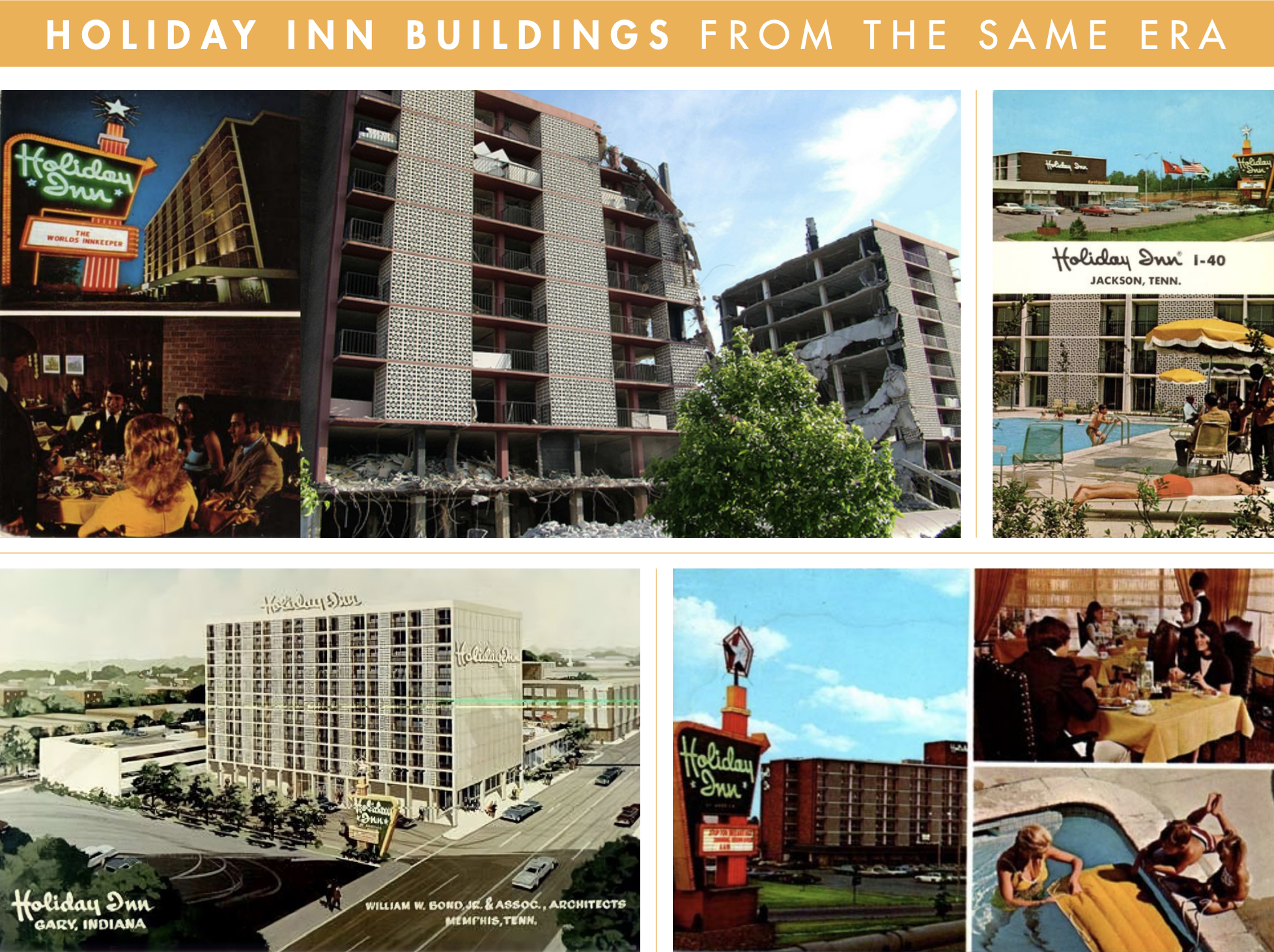 Similar Holiday Inn hotels were built around the country during the mid-20th century, but most have been demolished or renovated beyond recognition of their original Mid-Century Modern appearance. Images and postcards courtesy of National Register Database, Louisiana.
Similar Holiday Inn hotels were built around the country during the mid-20th century, but most have been demolished or renovated beyond recognition of their original Mid-Century Modern appearance. Images and postcards courtesy of National Register Database, Louisiana.
Advertisements

